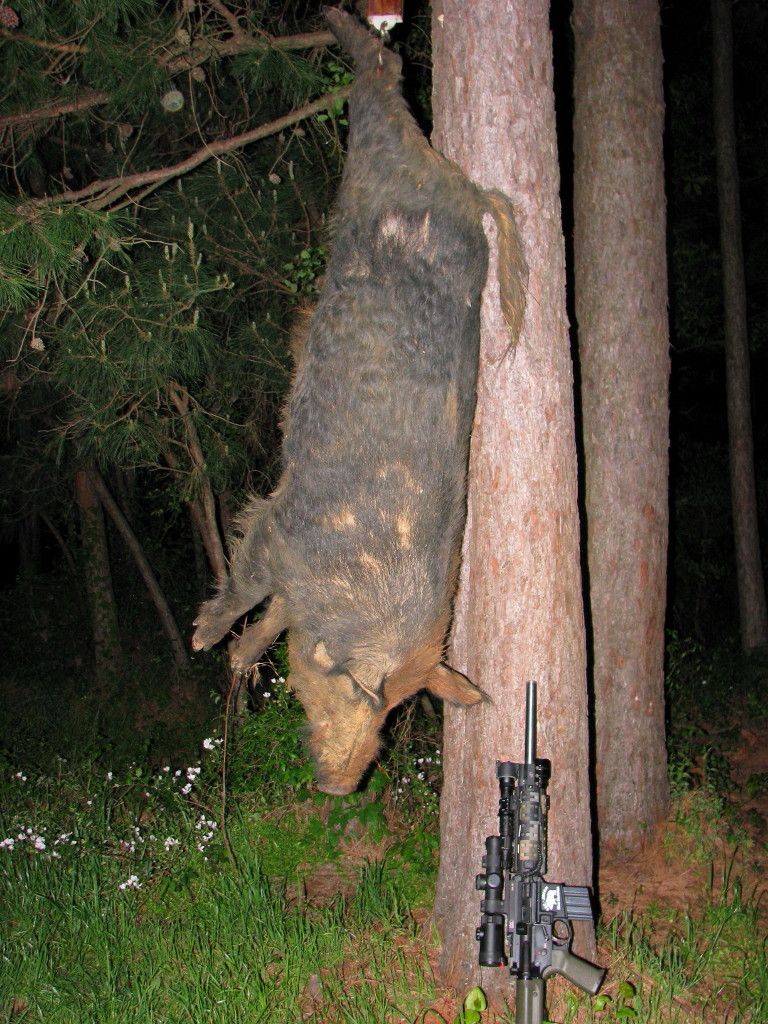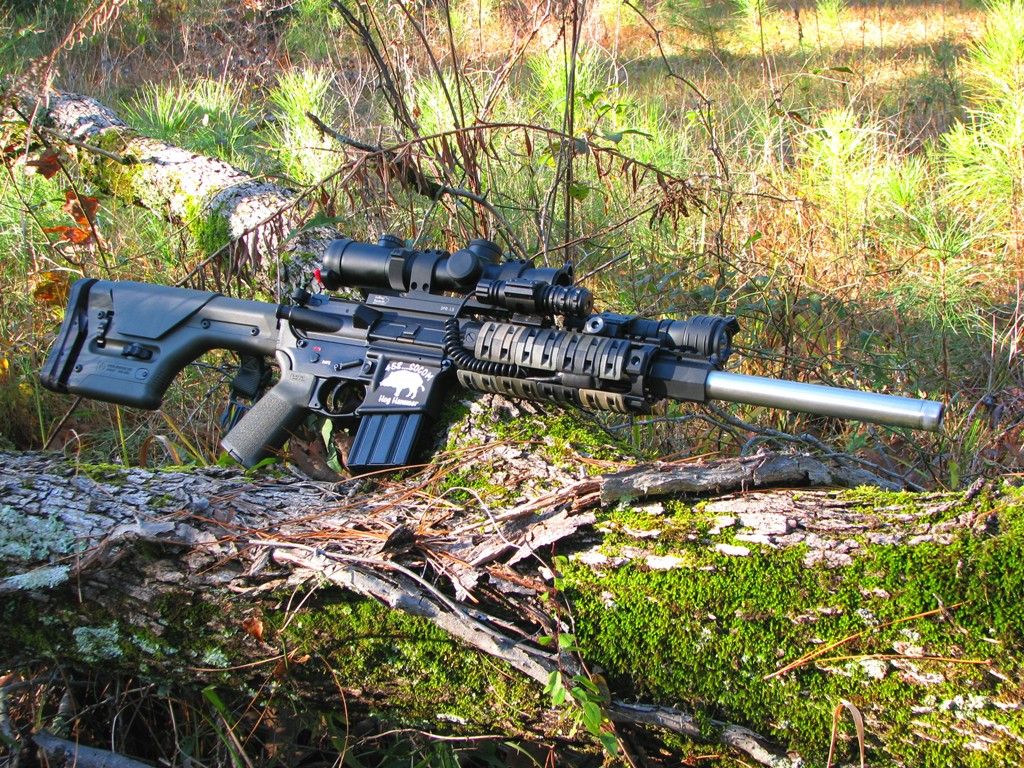Been after this guy for about a month. Seems like one thing or another would work to his favor.
Got it done about 9:30 tonight. No more rooting up the pasture for him.

Moderator: carlson1

puma guy wrote:Nice. What kind of set up do you have?

Very Nice! Keep up the good work annihilating future shoats.flintknapper wrote:puma guy wrote:Nice. What kind of set up do you have?
Purpose built hog rifle .458 SOCOM
Bullet used (this time) 405 grain jacketed soft point.
Sometimes I use a 300 grain bullet, other times a 540 grain bullet.
Specs:
Superior Lower
Geissele 2 Stage trigger
Magpul PRS stock
A4 upper
16” PacNor Super Match Barrel threaded for suppressor
YHM 4 rail
JP adjustable Gas Block
LaRue LT104 QD scope mount
1.5 x 4.5 x 24mm Weaver Classic Extreme, illuminated German #4 reticle
O-light M22 tactical light 950 lumens
AixiZ true 35 mW green laser
Shot placement: High shoulder shot (usually neck shoot them, but this hog was moving around too much).
Range…. 105 yards.
Very Nice! Keep up the good work annihilating future shoats.
The Annoyed Man wrote:Flint, did you have to go to the blood donor zone to get him?
Maybe, but it is common in some parts to let them lay where you shoot them.....reason being that if the vultures or coyotes haven't cleaned up the mess in 48 hours, the other hogs will do it. They are cannibalistic. And a big boar may not be worth eating, so inedible meat isn't really wasted. I've been hog hunting with a friend on his property.....which is strictly a hunting property some ways off the highway. When you shoot a hog there, unless you intend to eat it, you just let them run off to die.....or die where they're shot. If he shoots them near one of his feeders, he'll drag it off away from the feeder a little ways. But either way, he just lets them lay. The first time I was there, we went by a spot where he had shot a hog with his bow a week before, the arrow passing clean through, which had run off a 15 or 20 yards into the brush and gone down. When we walked to the spot a week later, there was nothing left but part of a jawbone, and some pig droppings with coarse hog hair in them.Abraham wrote:Flintknapper,
Is he small enough to eat?
Lately, on my bike rides well out in the country, I've come across hog remains where they only harvested the hams, and left the rest to rot, kinda sad.
They (who ever they are) didn't bother to skin or gut them, just cut off the hams and left the remains on the side of the road.
I've seen this ugly spectacle roughly a half dozen times on different rides in different places off in the ditch/side of country roads.
Part of me understands this approach as one whose killed, gutted, skinned, and butchered these critters. It's a hard, miserable job, so yeah, harvesting the hams only and perhaps the back straps is understandable. The waste though is painful to witness. Plus, why not simply bury the remains rather than leave the balance of the carcass to stink and create an ugly scene for the public to bear witness to?
Handling hogs this way makes hog killers look like ignoramuses.
At one sitting?Flintknapper,
Is he small enough to eat?
My objection here (along with yours) is the dumping of the carcass on the roadside (illegal by the way). As for the other matters, I do not know the circumstances involved, or the intent of the persons involved. Many folks are disturbed at the thought that an ENTIRE carcass is not utilized as a meat resource. Viewed...I suppose as 'wanton' waste. "Waste" by their definition meaning that humans did not consume it. I would argue that 'nature' does not waste... and makes very good use of the carcass.Lately, on my bike rides well out in the country, I've come across hog remains where they only harvested the hams, and left the rest to rot, kinda sad.
They (who ever they are) didn't bother to skin or gut them, just cut off the hams and left the remains on the side of the road.
Yes, I agree that the 'deliberate' disposal of a carcass along any public roadside is a disgraceful and disgusting act.I've seen this ugly spectacle roughly a half dozen times on different rides in different places off in the ditch/side of country roads.
Again, I would argue that it is "Waste", though the general public will in most cases view it the same way. Increasingly our society has become removed from understanding the workings of 'nature' and how the ecosystem operates. When a hog dies out in the woods, the carcass is consumed (quite rapidly I might add), by any number of scavengers, omnivores and insects. Each has its place in the ecosystem and this goes on everyday. First the scavengers consume the largest part of the meat, internal organs and then the edible bones. Various insects consume the remaining flesh and parts of the hide. The hooves, hair, hide and larger bones gradually decompose into nutrients for the soil. That is natures way.Part of me understands this approach as one whose killed, gutted, skinned, and butchered these critters. It's a hard, miserable job, so yeah, harvesting the hams only and perhaps the back straps is understandable. The waste though is painful to witness.
Lots of good reasons not to bury, but in the situation you described, I suspect laziness on the part of the actor or lack of a place to bury the carcass are at play.Plus, why not simply bury the remains rather than leave the balance of the carcass to stink and create an ugly scene for the public to bear witness to?
^^^^^^^^^ This applies to Domestic and Exotic Livestock. Feral hogs in recent years have been reclassified as Exotic Livestock. The States way of avoiding ownership and responsibility for them.The law states the TCEQ be notified by letter when an animal is buried. The letter should "contain your full name and address, the type of animal, and a short description of the location of the farm where the carcass was buried. Information on the anticipated capacity of the burial areas as well as the use of daily and/or final cover should be included, and a map showing the general location of the area would be useful." The letter should be mailed to: Industrial and Hazardous Waste Permits Section, MC-130, TCEQ, P.O. Box 13087, Austin, Texas 78711-3087.
"Hog Killers"?Handling hogs this way makes hog killers look like ignoramuses.